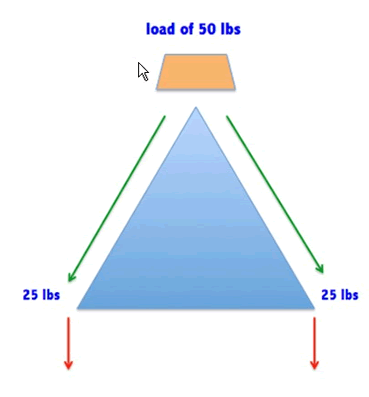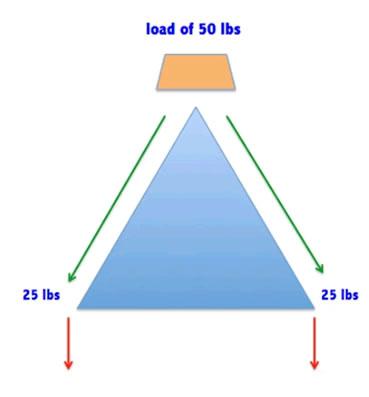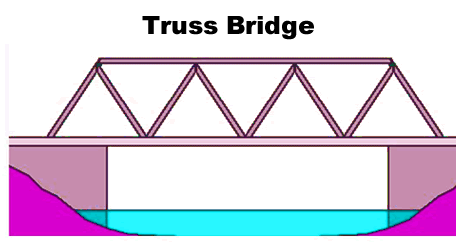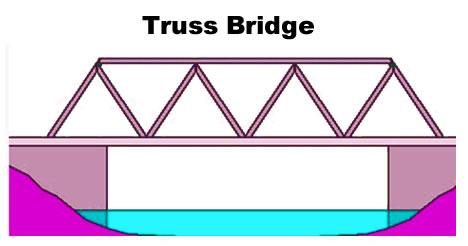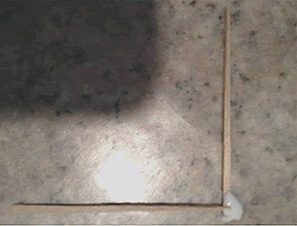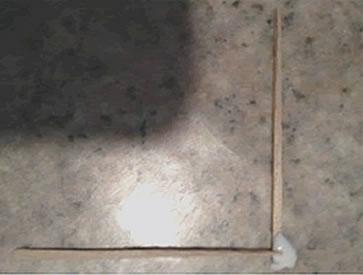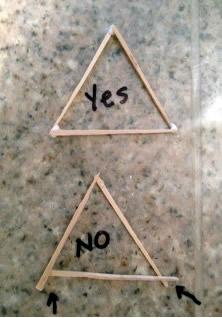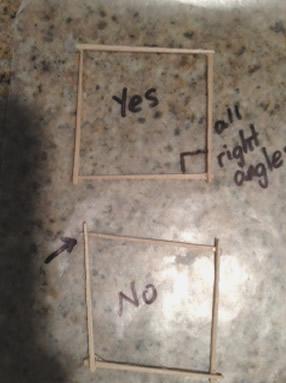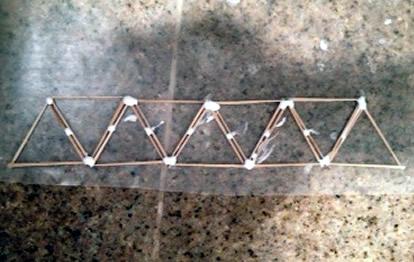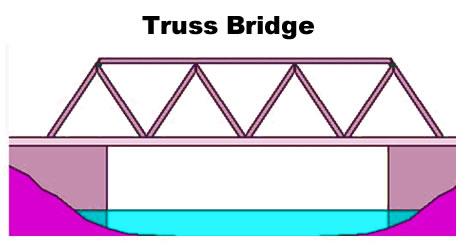| Complexity level: | 5 |
| Time required: | The glue needs to thoroughly dry (2-3 days) prior to testing the bridge's integrity and ability to bear a load. |
| Safety concerns: |
Hypothesis
Overview
Bridges are purposefully designed, or engineered, using geometric shapes that distribute force, thus making the structure strong enough to bear weight. Force is the "push" from the weight being placed on it. The bridge must bear not only the weight of the materials used to make the bridge, but also the weight of of any traffic travelling across it. One shape that distributes force effectively is a triangle.
But why is a triangle stronger than a square? This is because of how a triangle distributes or carries a force. When a load is placed at any vertex (corner) of a triangle, the force is evenly distributed and the shape remains stable. The force is carried equally to the base on both of its sides.

The square, on the other hand, has a weak center. The top of the square carries the force of the entire load. This is also why a roof of a house is so often trianglular in shape: a square roof will collapse more easily, but a triangular shaped roof will be very strong and stable.
In bridge design, triangles are used in a series or pattern to achieve structural strength. This set of connecting triangles used is called a truss. Connecting multiple triangles together as a truss forms a stronger structure than using just a single triangle.

Scientific Terms
Materials
- 1 box of flat toothpicks
- craft glue, wood glue or Elmer's glue
- cardboard (about 12" x 4")
- waxed paper
- paper towels
- small bucket
- rock material: gravel, pebbles or sand
- scoop or plastic cup
Procedure
1. Lay down two (2) sheets of waxed paper about 18 inches long.
2. Begin by making 18 triangles. You will need 54 toothpicks. Take three (3) toothpicks at a time (do not use any toothpicks that are splintered or broken) and place them on the waxed paper. Put a drop of glue on both ends of one (1) toothpick.
*Some glue will drip off the toothpick onto the waxed paper: that's OK, as the glue will only stick to the toothpick and not the waxed paper.
Place two more toothpicks in the glue at the tip of the first toothpick. For each vertex, place the skinny end of one toothpick on top of the fat end. Glue the third toothpick at the vertex to complete the triangle.

3. Carefully adjust the triangle so that no ends are overlapping and all toothpicks lay flat. Using a fourth toothpick as a tool to adjust the triangle is helpful. Wipe off any glue that gets on your fingers with a wet paper towel.

4. Next, make 10 squares. You will need 40 toothpicks. Take four (4) toothpicks at a time. Put a drop of glue on both the ends of one (1) toothpick. Place two more toothpicks in the glue at the tip of the first toothpick. For each vertex, place the skinny end of one toothpick on top of the fat end. Glue the third and fourth toothpick at the vertex to complete the square.
5. Adjust all toothpicks so they lay flat and have no overlapping edges at the vertex. Make sure all vertexes are right angles.

6. Allow all triangles and squares to dry 24 hours.
7. Now, build two (2) trusses by placing the triangles in an alternating pattern (shown in the picture below) then gluing together the single triangles. Let dry at least 4 hours.

8. Next, build two (2) square shaped trusses by gluing together the single squares. Let dry 4 hours.
9. Stand up the two triangle trusses (an extra hand from your parents would prove useful) and glue a connecting toothpick at the vertex of the middle triangle of each truss to form a "roof" for your bridge. Continue to glue connecting toothpicks at each triangle's vertex.
10. Repeat the process in step 9 with the two square trusses.
11. Allow both finished bridge models to dry for at least 12 hours.
12. Finally, test how much force each bridge model can hold.
To do this, place a 12" x 3" piece of cardboard on top of one bridge. This simulates the bridge deck. Place the bucket on top of the center of the cardboard. Pour the rock material (gravel, pebbles or sand) into the bucket one (1) scoop at a time. Wait briefly before adding each scoop to observe any shifting, buckling or collapsing of the trusses.
13. Record how many scoops of rock material it took to collapse each bridge.
